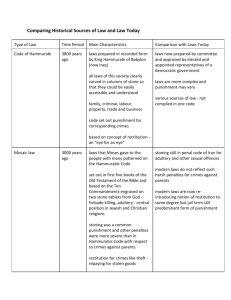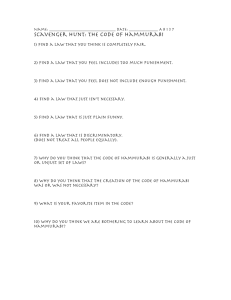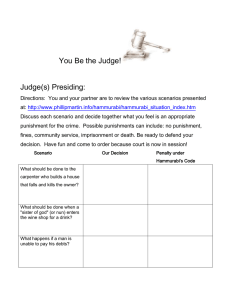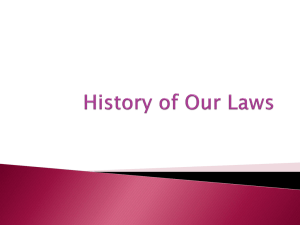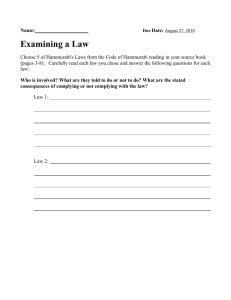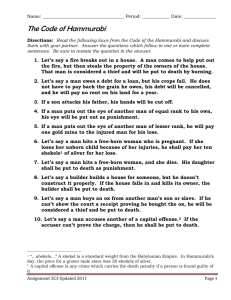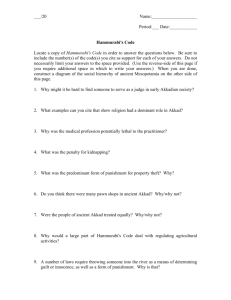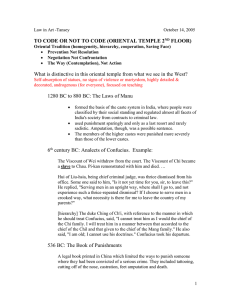LCP Unit 1A History pwer point
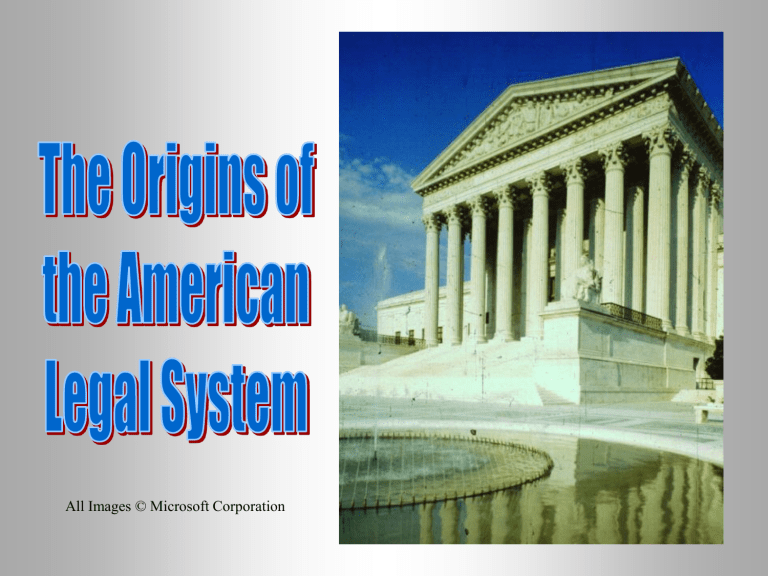
All Images © Microsoft Corporation
2350 BC: Urukagina's Code
• Consolidation of existing laws laid down by Mesopotamian kings.
•
Reform document which allowed citizens to know why certain actions were punished
–
1st known established legal code
2350 BC: Urukagina's Code
•
Harsh by modern standards.
–
Thieves and adulteresses were to be stoned to death with stones inscribed with the name of their crime.
•
The code confirmed that the "king was appointed by the gods".
–
Godly authority would not be challenged
2050 BC: Ur-Nammu's Code
•
Advanced legal system which included:
– specialized judges
– the giving of testimony under oath
– format for judicial decisions
– damages paid to victim
2050 BC: Ur-Nammu's Code
•
The Code allowed for:
– dismissal of corrupt justices
– protection for the poor
– punishment proportional to the crime.
Earliest Documented Legal Decision
• A clay tablet reveals the case of the murder of a temple employee by three men. The victim's wife knew of the murder but remained silent. Nine witnesses testified against the men and woman and asked for the death penalty for all four. But the wife had two witnesses which told the court that she had been abused by her husband, that she was not part of the murder and that she was even worse off after her husband's death. The men were executed in front of the victim's house but the woman was spared.
1700 BC: Hammurabi's Code
• Carved on a huge rock column
•
"an eye for an eye" has come to symbolize the code
• All accused had a trial
•
Code gave vast empire stability
• Appeals, equal access for women, protection for the poor provided
1700 BC: Hammurabi's Code
• 282 clauses regulating:
– obligations
– professions
– commerce
– slavery
– marriage
– theft
– debts
1700 BC: Hammurabi's Code
• Lex Talionis - Eye for an eye, tooth for tooth
•
Suspicion was not grounds for trial
• Accused must be caught in act
•
No lawyers
• Capital trial required a panel of judges and a panel of elders
1700 BC: Hammurabi's Code
• Other trials had 1 judge and 12 elders
•
Witnesses took oath
• Ordeal by water used in cases beyond the knowledge of men
– wizards, suspected wives
• Capital penalty common punishment
1700 BC: Hammurabi's Code
• The punishment for theft was the cutting off of a hand or death. A man's lower lip was cut off if he kissed a married woman. Defamation was punished by cutting out the tongue. If a house collapses because the builder did not make it strong enough, killing the owner, the builder was put to death. If the owner's son died, then the builder's son was executed, the loss of the eye that pried into forbidden secrets, cutting off the hand that struck a father
1300 BC: The Ten Commandments
• Continues today in the form of modern laws
•
Exodus follows the recitation of the
Commandments (20:1) with a complete set of Hammurabi's Code
(21:1)
1300 BC: The Ten Commandments
1. Prefer no other gods to me.
2. Do not make for yourselves any graven image
3. Do not misuse my name.
4. Keep the Sabbath
5. Honor your Parents
1. None
2. None
3.Vulgarity prohibited
- Obscenity
4. Blue Laws
5. Custody, Unruly
Child
1300 BC: The Ten Commandments
6. Do not kill.
7. Do not commit adultery.
8. Do not steal.
9. Do not bear false witness.
10. Do not covet your neighbor's house.
6. Murder
7. Adultery, Sodomy,
Fornication
8. Property Crime theft
9. Perjury, defamation
10. “Man’s Castle”
621 BC: Draco's Law
• The first written laws of Greece
•
Introduced the state's exclusive role in punishing persons accused of crime
– removed private justice and priestly judgement
•
The penalty for many offences was death
621 BC: Draco's Law
• "draconian" comes from his name and has come to mean, in the English language, an unreasonably harsh law
• The citizens adored Draco and upon entering an auditorium one day to attend a reception in his honor, the citizens of Athens showered him with their hats and cloaks as was their customary way to show appreciation. By the time they dug him out from under the clothing, he had been smothered to death.
600 BC: Lycergus' Law
• Designed to support the military vocation of Sparta
•
Greatest crime was retreat in battle
• Controlled virtually every aspect of the lives of citizen
• It held that women had a duty to have children and that children born with deformity were killed.
Children became wards of Sparta at the age of seven to prepare them for military duty
536 BC: The Book of Punishments
• A legal book printed in China which limited the ways to punish someone where they had been convicted of a serious crime.
•
They included tattooing, cutting off of the nose, castration, feet amputation and death.
450 BC: The Twelve Tables
• These laws are considered to form the foundation of all modern law
•
Organized public prosecution of crimes
• Instituted a system whereby injured parties could seek compensation from their aggressors
450 BC: The Twelve Tables
• Protected the lower class (plebes) from the legal abuses of the ruling class (the patricians) especially in the enforcement of debts
•
Basic principle of Roman law is that the law must be written and justice cannot be left in the hands of judges alone to interpret
450 BC: The Twelve Tables
• The modern legal systems are not based directly on the legal system of
Rome.
•
They are European Ius Commune -
Roman Law as it was interpreted and reshaped by medieval jurists
350 BC: Code of Li k'vei
•
The first Chinese imperial code of laws dealt with theft, robbery, prison, arrest and general rules
529 AD: Justinian's Code
• Corpus Juris Civilis
•
Inspired by logic-based Greek legal principles.
• Many legal maxims still in use today
•
Inspired the modern concept and the very spelling of "justice”
529 AD: Justinian's Code
• This Roman Code survived in many parts of Germany until 1900
•
Important traces of it can be found in the law from Africa to Canada
• Formed the base of civil law
529 AD: Justinian's Code
• One of the two main legal systems to govern modern society in the Western civilization, the other being English common law
•
"The things which are common to all
(and not capable of being owned) are: the air, running water, the sea and the seashores."
653: T'ang Code
• Listed crimes and their punishment in 501 articles
•
The Code revised earlier existing
Chinese codes and standardized procedures.
• There were only two ways to perform capital punishment on a convicted criminal: beheading or hanging.
1100: First Law School
• In medieval Italy, students of law would hire a teacher to teach them
Roman Law, especially Justinian's
Code
•
One teacher, known as Irnerius was particularly popular and students began to flock to him from all over
Europe.
1100: First Law School
• Irnerius taught in Bologna and the surge of students meant that he had to hire other teachers to form the world's first law school.
•
By 1150, his law school had over
10,000 students and contributed to the revival of the Corpus Juris throughout Europe
1215: Magna Carta
• Called the "blueprint of English common law”
•
Conceded a number of legal rights to his barons and to the people
• It was the first time a king allowed that even he could be compelled to observe a law
1215: Magna Carta
• Committed to rudimentary judicial guarantees such as the freedom of the church, fair taxation, controls over imprisonment (habeas corpus)
•
Clause #39: "No freeman shall be captured or imprisoned ... except by lawful judgement of his peers or by the law of the land".
1306: The Trial of Scotsman
William Wallace
• Edward I had actually instituted many legal reforms in England, some of which still stand today
•
The professions of "barrister" and
"solicitor" were created
• He also supervised the development of civil procedures and extensive laws on property
1306: The Trial of Scotsman
William Wallace
• But the law meant little when it came to the William Wallace
•
In spite of Edward's commitment to the law, Wallace was given no legal rights or privileges. His trial and punishment were typical of law and order in the medieval ages
British Common Law
• An unwritten system of law based on judicial decisions, usages, and customs of the land
•
Legal precedent is based on common law
• Origin of most laws and procedure in our system
British Law in the 1500’s
• peine forte et dure - when a prisoner refused to answer to a felony charge
–
The prisoner was laid on the floor naked and his hands and feet were tied up and stretched in opposite directions, towards the four corners of the room. A board was laid on his chest, and weights were laid.
More weight was added "till he die or answer." This lasted from 1406 to 1772
British Law in the 1500’s
• Between the years 1500 and 1550 alone, over 70,000 state executions were carried out in England alone.
•
As late as 1780, the British criminal law contained over 350 offences for which the punishment was death.
1689: The English Bill of Rights
• Set out strict limits on the Royal
Family's legal prerogatives such as a prohibition against arbitrary suspension of Parliament's laws and limited the right to raise money through taxation to Parliament.
•
The king agreed to be subject to law and to be guided by Parliament.
1689: The English Bill of Rights
• Ended the concept of divine right of kings
•
Designed to control the power of kings and queens and to make them subject to laws passed by Parliament
1740: South Carolina Slave Code
• Legislation regulated the use of slaves and became the model for slavery in other states
•
"All Negroes, Indians...and all their offspring...shall be and are hereby declared to be and remain forever slaves; and shall be deemed ... to be chattels personal in the hands of their owners."
1787: The Constitution of the
United States of America
• Defined the duties of the executive, legislative and judicial branches
•
Declared that it was paramount to any other law, whether federal or state
1791: The American Bill of Rights
• More coming later
1804: Napoleonic Code
• Under Napoleon, France adopted a comprehensive code of law
•
Protected individual liberty, equality before the law and the lay character of the state
• Incorporated most parts of Roman law
1804: Napoleonic Code
• Became a model for civil law systems such as Quebec, California and
Louisiana
•
The most important aspect of the
Code was the fact that the law was written (as opposed to judge-made) and in a non-technical style and thus more accessible to the public
1804: Napoleonic Code
• Regulated much of private law matters such as property, wills, contracts, liability and obligations.
Many of its parts are traceable to
Roman law.
• Still used in Louisiana
1945-46: The Nuremberg War
Crimes Trial
• Special panel of eight judges convened in this German town to try
Nazi officers for crimes against peace, crimes against humanity
•
1st real international trial
1948: The General Agreement on
Tariffs and Trade (GATT)
• Implementation of GATT by almost all countries is causing commercial law interplay between differing legal systems
• This with United Nations may result in a world court
All Images © Microsoft Corporation
